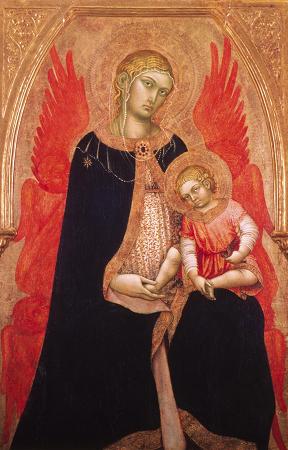
Taddeo di Bartolo. Taddeo di Bartolo, also known as Taddeo Bartoli, was an Italian painter of the Sienese School during the early Renaissance.
He is among the artists profiled in Vasari's biographies of artists or Vite. Vasari claims he is the uncle of Domenico di Bartolo.
Taddeo di Bartolo was born in Siena. The exact year of Taddeo di Bartolo's birth is unknown, but it's been suspected to be between 1363-65.
Around 1389 he entered the Sienese Guild of artists, where he mastered the art of painting among his Sienese colleagues. In 1389 Taddeo traveled to Collegarli, the San Miniato al Tedesco hills, and Pisa.
The painting of The Virgin and Child Enthroned, signed and dated in 1390 and created the church of San Paolo in Pisa, is one of Taddeo's first documented works. In 1393, Taddeo traveled to San Gimignano, where he executed the altarpiece of the Virgin and Child and Saints for the Sardi and Campigli Chapel in San Francesco. The Virgin and Child With Saints showcases Taddeo's earlier style. The thin, elegant figures, and flowing lines of the drapery patterns reflect influence from his Sienese predecessors, such as Simone Martini and Ambrogio Lorenzetti. From 1400-01, Taddeo worked at the Palazzo Pubblico in Siena where he created twelve small panels, of which only nine exist today, displayed at the Opera of the Duomo in Siena. These panels give reverence to Taddeo's craftsmanship in smaller sc
He is among the artists profiled in Vasari's biographies of artists or Vite. Vasari claims he is the uncle of Domenico di Bartolo.
Taddeo di Bartolo was born in Siena. The exact year of Taddeo di Bartolo's birth is unknown, but it's been suspected to be between 1363-65.
Around 1389 he entered the Sienese Guild of artists, where he mastered the art of painting among his Sienese colleagues. In 1389 Taddeo traveled to Collegarli, the San Miniato al Tedesco hills, and Pisa.
The painting of The Virgin and Child Enthroned, signed and dated in 1390 and created the church of San Paolo in Pisa, is one of Taddeo's first documented works. In 1393, Taddeo traveled to San Gimignano, where he executed the altarpiece of the Virgin and Child and Saints for the Sardi and Campigli Chapel in San Francesco. The Virgin and Child With Saints showcases Taddeo's earlier style. The thin, elegant figures, and flowing lines of the drapery patterns reflect influence from his Sienese predecessors, such as Simone Martini and Ambrogio Lorenzetti. From 1400-01, Taddeo worked at the Palazzo Pubblico in Siena where he created twelve small panels, of which only nine exist today, displayed at the Opera of the Duomo in Siena. These panels give reverence to Taddeo's craftsmanship in smaller sc
Wikipedia ...